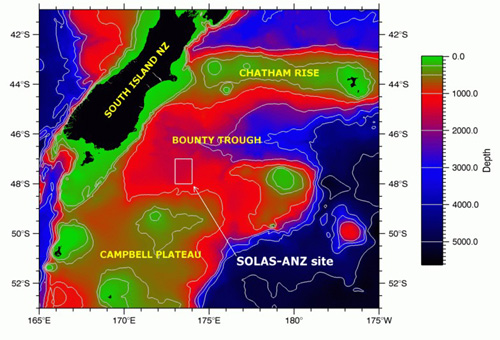 |
Near
Surface Gradients During the SOLAS Air-Sea Gas Experiment (SAGE) Cruise
The SOLAS Air-Sea Gas Experiment (SAGE) will be conducted southeast of New
Zealand in the vicinity of the S.W. Bounty Trough at 48°S, 173°E.
An objective is to study the exchange of climate-relevant gases between
the ocean and atmosphere. In the Southern Ocean, temperatures are generally
low and the ocean surface is exposed to strong winds and waves. The addition
of iron sulphate is planned to stimulate a plankton bloom, which should
provide an enhancement of gas fluxes to study. The corresponding modification
to the gas transfer will be quantified with the dual tracer technique, as
well as micrometeorological methods. The cruise is funded by the New Zealand
Foundation for Research Science and Technology (FRST) and will be using
the National Institute of Water and Atmospheric Research (NIWA) research
vessel Tangaroa.
WHOI participation (PI: Brian Ward) is through
a collaborative NSF-funded grant with the Rosenstiel School of Marine and
Atmospheric Science (PI: Peter Minnett). This participation will involve
the deployment of the SkinDeEP profiler and M-AERI spectroradiometer. SkinDeEP
is equipped with high-resolution temperature and conductivity sensors to
investigate microstructure from a depth of 10 m to the surface. Its measurement
capability has been extended with the addition of oxygen, irradiance, and
fluoresence sensors. The M-AERI spectroradiometer will provide highly accurate
ocean skin temperature measurements, which is the temperature where the
ocean is in direct contact with the atmosphere. High-resolution
O2 profiles will allow quantification of biological production and consumption
in the surface layer. Irradiance and fluoresence measurements will also
provide an indicator of biological activity through the absorption of light.
These measurements will be conducted both inside and outside the fertilized
patch. For further information, contact Brian
Ward.
|

